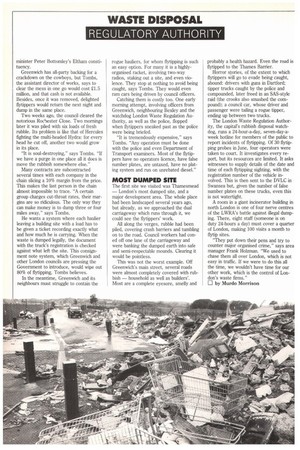minister Peter Bottomley's Mani constituency.
Page 26

If you've noticed an error in this article please click here to report it so we can fix it.
Greenwich has all-party backing for a crackdown on the cowboys, but Tombs, the assistant director of works, says to clear the mess in one go would cost £1.5 million, and that cash is not available. Besides, once it was removed, delighted flytippers would return the next night and dump in the same place.
Two weeks ago, the council cleared the notorious Rochester Close, Two mornings later it was piled with six loads of fresh rubble. Its problem is like that of Hercules fighting the multi-headed Hydra: for every head he cut off, another two would grow in its place.
"It is soul-destroying," says Tombs. "If we have a purge in one place all it does is move the rubbish somewhere else."
Many contracts are subcontracted several times with each company in the chain slicing a 10% margin from the price. This makes the last person in the chain almost impossible to trace. "A certain group charges cut-throat rates, their margins are so ridiculous. The only way they can make money is to dump three or four miles away," says Tombs.
He wants a system where each haulier leaving a building site with a load has to be given a ticket recording exactly what and how much he is carrying. When the waste is dumped legally, the document with the truck's registration is checked against what left the site. This consignment note system, which Greenwich and other London councils are pressing the Government to introduce, would wipe out 80% of flytipping, Tombs believes.
In the meantime, Greenwich and its neighbours must struggle to contain the rogue hauliers, for whom flytipping is such an easy option. For many it is a highlyorganised racket, involving two-way radios, staking out a site, and even violence. They stop at nothing to avoid being caught, says Tombs. They would even ram cars being driven by council officers.
Catching them is costly too. One early morning attempt, involving officers from Greenwich, neighbouring Bexley and the watchdog London Waste Regulation Authority, as well as the police, flopped when flytippers sneaked past as the police were being briefed.
"It is tremendously expensive," says Tombs. "Any operation must be done with the police and even Department of Transport examiners. Most of the flytippers have no operators licence, have false number plates, are untaxed, have no plating system and run on unrebated diesel."
MOST DUMPED SITE
The first site we visited was Thamesmead — London's most dumped site, and a major development area. The whole place had been landscaped several years ago, but already, as we approached the dual carriageway which runs through it, we could see the flytippers' work.
All along the verges, rubble had been piled, covering crash barriers and tumbling on to the road. Council workers had coned off one lane of the carriageway and were banking the dumped earth into safe and semi-respectable mounds. Clearing it would be pointless.
This was not the worst example. Off Greenwich's main street, several roads were almost completely covered with rubbish — household as well as builders'. Most are a complete eyesore, smelly and probably a health hazard. Even the road is flytipped to the Thames Barrier.
Honor stories, of the extent to which flytippers will go to evade being caught, abound: drivers with guns in Dartford; tipper trucks caught by the police and compounded, later freed in an SAS-style raid (the crooks also smashed the compound); a council car, whose driver and passenger were tailing a rogue tipper, ending up between two trucks.
The London Waste Regulation Authority, the capital's rubbish disposal watchdog, runs a 24-hour-a-day, seven-day-aweek hotline for members of the public to report incidents of flytipping. Of 30 flytipping probes in June, four operators were taken to court. It investigates every report, but its resources are limited. It asks witnesses to supply details of the date and time of each flytipping sighting, with the registration number of the vehicle involved. This is then sent to the DVLC in Swansea but, given the number of false number plates on these trucks, even this is not watertight.
A room in a giant incinerator building in north London is one of four nerve centres of the LWRA's battle against illegal dumping. There, eight staff (someone is on duty 24-hours a day) must cover a quarter of London, making 100 visits a month to flytip sites.
"They put down their pens and try to counter major organised crime," says area manager Frank Holzman. "We used to chase them all over London, which is not easy in traffic. If we were to do this all the time, we wouldn't have time for our other work, which is the control of London's waste firms."
El by Murdo Morrison










































